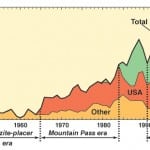Few topics demonstrate the power of free markets to overcome economic hurdles better than the case of rare earth minerals. For years now, as we have followed the issue in this magazine, the government of the Peoples’ Republic of China has sought to leverage its position as a major producer of the minerals that are at the heart of many advanced energy technologies, including high-density batteries, wind turbines and electric cars.
But the result of the Chinese imposition of trade barriers design to protect a resource monopoly has been the exact opposite of the intent of Beijing’s deluded government planners. Supplies not under Chinese control have sprung up to compete in world markets that Beijing does not control. Substitutes have emerged to displace the rare earth minerals.
Japanese geologists have discovered large quantities of rare earth minerals under the surface of the ocean, promising “a plentiful supply once the technology is developed to get to them.” According to Tokyo University professor Yajuhiro Kato, the team leader, quoted in the Telegraph, “We have found deposits that are just two to four metres from the seabed surface at higher concentrations than anybody ever thought existed, and it won’t cost much at all to extract.” Kato led the project for Japan’s Agency for Marine Earth Science. The discovery of the minerals could upend China’s monopoly of the minerals, which it has used to restrict sales and keep prices high.
Japan consumes half of the world’s 17 rare earth minerals, particularly those at the heavier end of the scale, which are the least plentiful. Tokyo University’s Kato said it isn’t necessary to mine large amounts of the minerals from the new discovery. “We don’t need to mine it intensively,” he said. “All we need is enough to force China to lower its prices.”
Given the developments in the world supply of the minerals, the U.S. advisory group that Congress charged with looking at the nation’s vulnerability to foreign control of the critical minerals advised the solons to chill out and take a different approach to rare earths. The Defense Department’s Strategic Minerals Advisory Council is advising the Pentagon to move away from stockpiling rare earths in favor of a domestic supply strategy.
Jeff Green, executive director of the minerals council, said the government should adopt “the only appropriate and permanent solution—the creating of a U.S.-based rare earth supply chain.” That’s not likely to happen. But what would that government supply chain look like? The evidence is scant. A bill introduced by Reps. Henry “Hank” Johnson (D-Ga.) and Ed Markey (D-Mass.) calls for a “comprehensive report on global rare earth element resources and potential future global supply.”
That’s a first step – but hardly guarantees that Congress will take any additional steps—toward a national policy on rare earth minerals, including a national stockpile. The crux of the minerals advisory committee report was that the government should eschew a national stockpile, as it has adopted for such commodities as petroleum and helium.
Price increases for rare earth minerals also drive ways to use the minerals more efficiently, driving down the costs and minimizing the dependence on unstable suppliers. Ford has announced that it has developed new ways to use fewer of the minerals to achieve the same levels of output.
Companies are also finding ways to use other elements, not under control of unpredictable foreign governments, to accomplish their needs. Honda says it has a technology for recycling rare earth minerals used in batteries that recovers 99% at a cost that it believes will be competitive with commodity mineral prices.
Substitution is also at work. The Wall Street Journal noted that “Ford and other are discovering many modern technologies need not rely on rare earths at all. And as the costs of rare earths increase while the dependability of Chinese supply decreases, the incentive only grows for engineers to come up with ways to use some other input. No technology stays indispensable forever. Just ask the candlemakers.”
Finally, it is a fact of nature that “rare” earths are just not all that rare. Most of the rare earth elements are relatively plentiful in the earth’s crust (just widely dispersed). As prices, now set by the Chinese cartel, rise, prospectors are finding the minerals elsewhere in commercial quantities. The Arizona Daily Star newspaper reports that high global prices are driving prospecting in the U.S., with favorable results. The newspaper reported, “State geologists for Arizona and New Mexico and a top University of Arizona mineral researcher say potential exists for finding economically viable deposits here—possibly with the state’s extensive copper deposits. One reason for their optimism: Arizona has some rock formations similar to those where rare earth elements have been found in New Mexico.”
Some organizations see the prospects of developing these mineral resources in the U.S. as requiring government action to remove regulation. That National Center for Policy Analysis in a new study has called for the U.S. to reform its mine permitting process to spur increased production. Says analyst Tom Tanton, author of Rare Earths Mining Potential in the United States, “The dependence on foreign sources such as China for our supplies of these critical elements must end and it can.”
—Kennedy Maize is MANAGING POWER’s executive editor.








